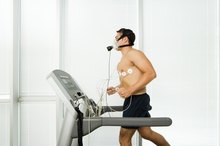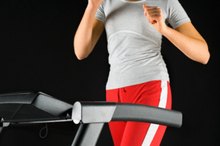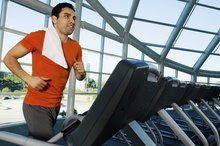What Are the Characteristics of Cardiorespiratory Fitness Exercise?
Cardiovascular exercises come in a variety like a color chart at a rug store, spanning from long-distance running to circuit weight training and partner dancing. Regardless of what type of cardiovascular exercises you enjoy doing, they all share characteristics that effect how long you would last and perform in a training session.
Heart Rate and Stroke Volume
Heart rate is generally an indicator of your cardiovascular health, which is usually measured in beats per minute, or bpm, when you're at rest. According to Sports Fitness Advisor, the average adult resting heart rate ranges between 60 to 80 bpm, while sedentary and unfit adults can get as high as 100 bpm. Cardiovascular exercise can help bring down your resting heart rate to the normal range by getting your heart stronger as it adapts to the exercise. This increases the stroke volume, which is the amount of blood ejected from the left ventricle of the heart. It healthy adults, the stroke volume ranges 50 to 70 milliliters per beat, while elite endurance athletes can get as high as 150 to 220 milliliters per beat. The increase in stroke volume is caused by more blood filling in the left ventricle, which causes the heart chamber to enlarge and allows the blood to elastically recoil to produce a more forceful contraction. Thus, heart rate and stroke volume go hand-in-hand in estimating general cardiovascular health.
VO2max
How to Calculate VO2 Reserve
Learn More
VO2max is the highest rate your body can use oxygen during exercise in one minute. Researchers not only use this characteristic to measure cardiovascular health, but also they use VO2max as a way to measure approximately how much calories you're using during exercise. Exercise physiologist Len Kravitz of University of New Mexico states that there is a correlation between VO2max and age and gender. Women generally have lower VO2max than men because their hearts are smaller and they have less muscle mass than men, which can determine how much oxygen is used. Men and women can lose 44 percent and 34 percent of their aerobic power, respectively, between the ages of 20 and 60. Regular cardiovascular exercise can delay or reverse the aging effects of your cardiovascular system.
Exercise Duration
Duration of cardiovascular exercise varies between 30 seconds to several hours, depending on the exercise intensity and type. Although short-duration, high-intensity exercise -- such as sprinting and heavy weightlifting -- aren't usually considered as "cardio," they still tax the cardiovascular system and elicit a metabolic response that is akin to long endurance training. Kravitz reviewed a 1988 study published in "American Journal of Medicine and Science" that heavy resistance training elevated and sustained a high metabolic rate for several hours like aerobic cycling when both exercise session are trained at about 80 percent of the maximum heart rate. Exercise duration should also reflect on the cardiovascular demand of the sport or activity that you play, says speed coach Randy Smythe. For example, because tennis requires bursts of speed acceleration and quick deceleration and direction change for a few hours during a match, tennis players should train with short bouts of sprinting rather than long-duration, steady-pace cardio.
Lactate Threshold
What Happens During Exercise at 90% of Maximum Heart Rate?
Learn More
Although VO2max measures how strong your cardiovascular fitness is, lactate threshold determines how long you can sustain a bout of exercise. Lactate is produced in your muscles during glucose metabolism without the presence of oxygen to provide short-term fuel. Lactate is removed from your muscles via your bloodstream and is transported to your liver to be recycled back to glucose, which is transported back to your muscles to provide more fuel. When the rate of lactate accumulation in your muscles exceeds the rate of lactate removal, your body reaches the lactate threshold. Muscle cramps and fatigue begin to develop, which forces you to stop exercising. However, the more fit you are, the higher your lactate threshold becomes. A study published in "Journal of Applied Physiology" demonstrated that trained men had a 34 percent higher lactate threshold than untrained men.
Related Articles
References
- Sports Fitness Advisor: The Cardiovascular System and Exercise
- San Diego State University, Exercise and Nutrition Studies: Substrate Utilization
- British Journal of Sports Medicine: Maximal Oxygen Intake and Independence in Old Age
- Medicine and Science in Sports and Exercise: A 45-Minute Vigorous Exercise Bout Increases Metabolic Rate for 14 Hours
- Journal of Applied Physiology: Lactate Kinetics at the Lactate Threshold in Trained and Untrained Men
- IDEA Health & Fitness Association: Assessing the Lactate Threshold
- Medicine and Science in Sports and Exercise: Effect of Intensity of Aerobic Training on VO2max
- Randy Smythe Speed Training: Tennis Fitness and Tennis Slowness
- Dr. Len Kravitz: Maximal Aerobic Power and Functional Independence in Older Adults
Resources
Writer Bio
Nick Ng has been writing fitness articles since 2003, focusing on injury prevention and exercise strategies. He has covered health for "MiaBella" magazine. Ng received his Bachelor of Arts in communications from San Diego State University in 2001 and has been a certified fitness coach with the National Academy of Sports Medicine since 2002.









